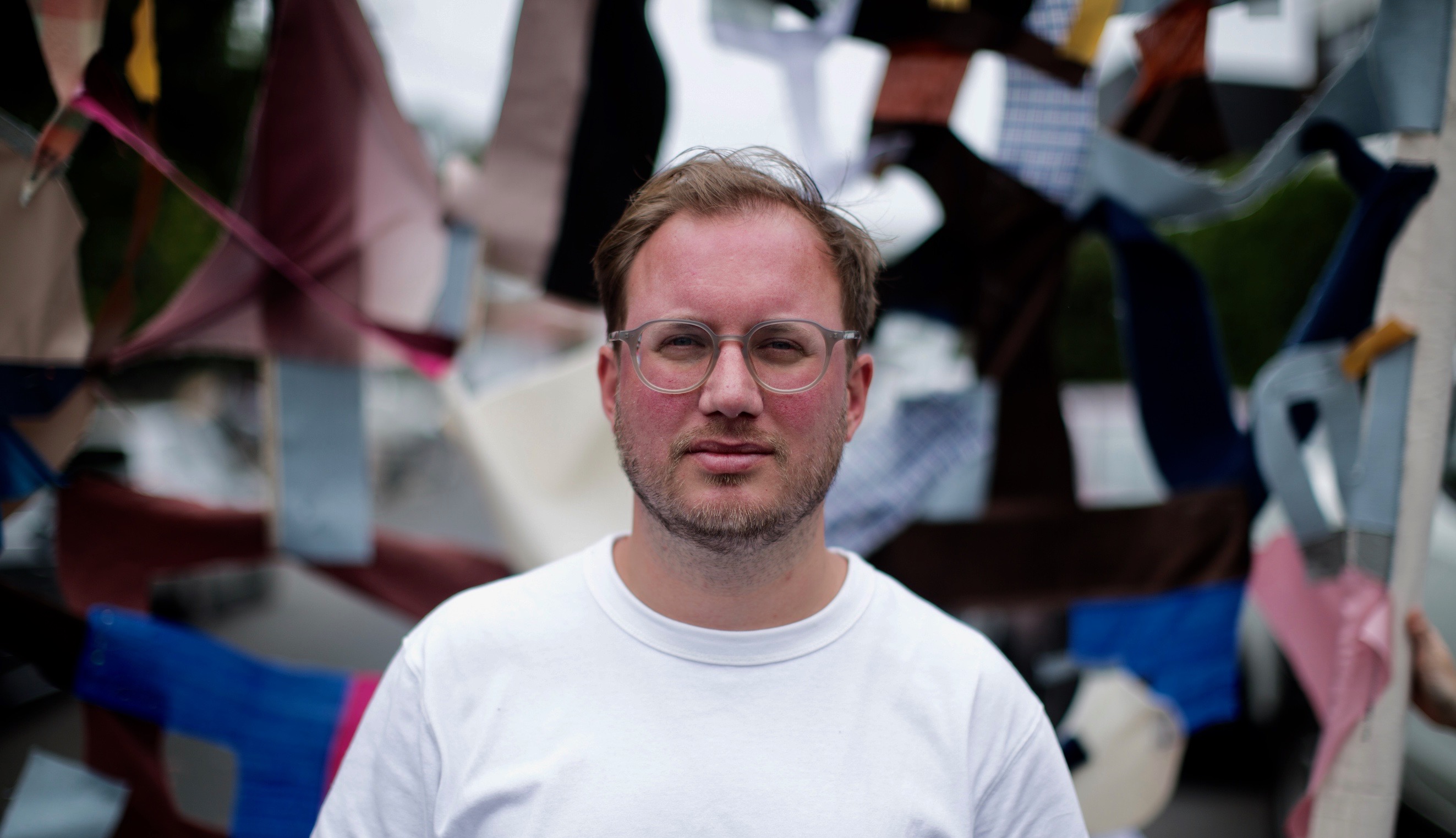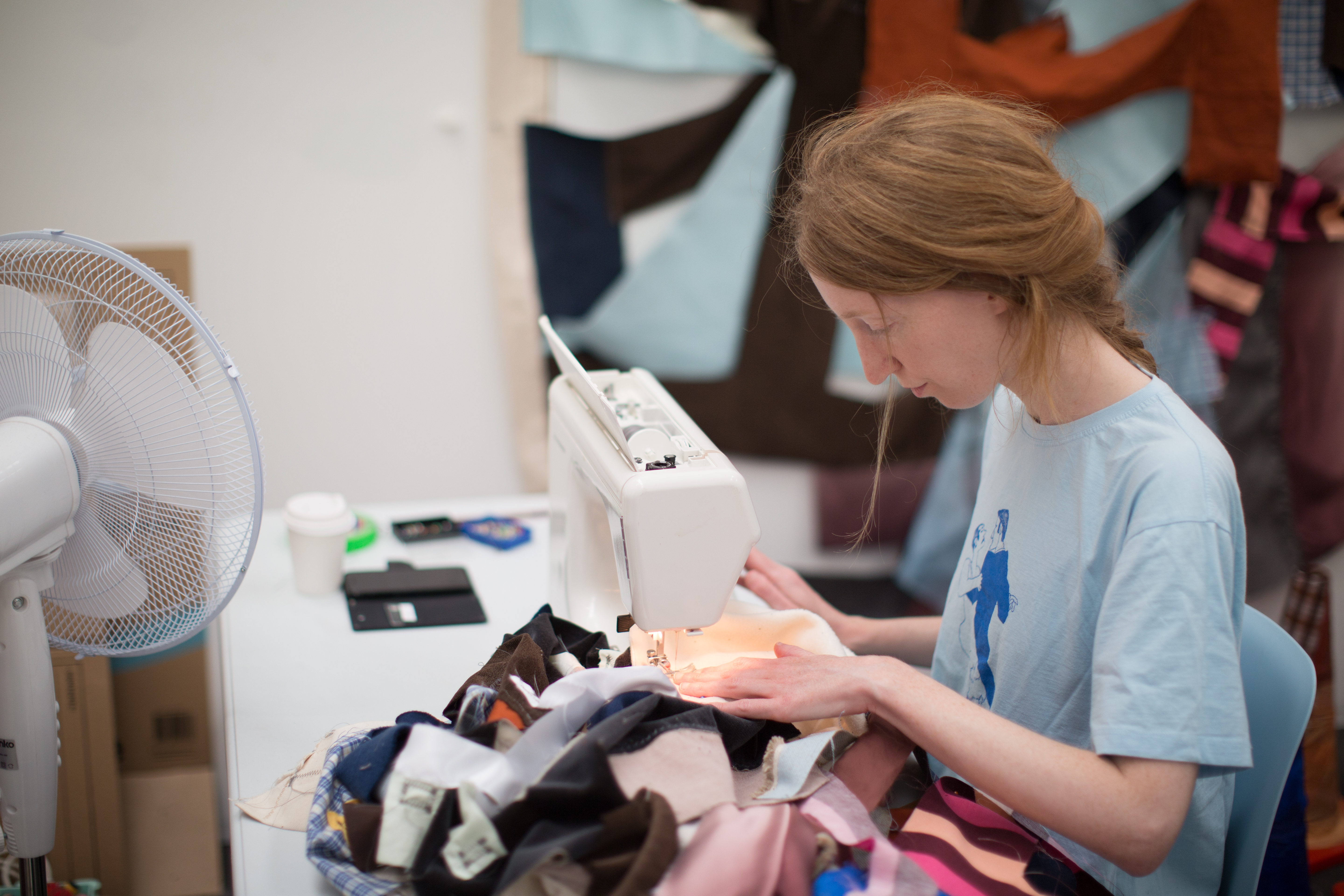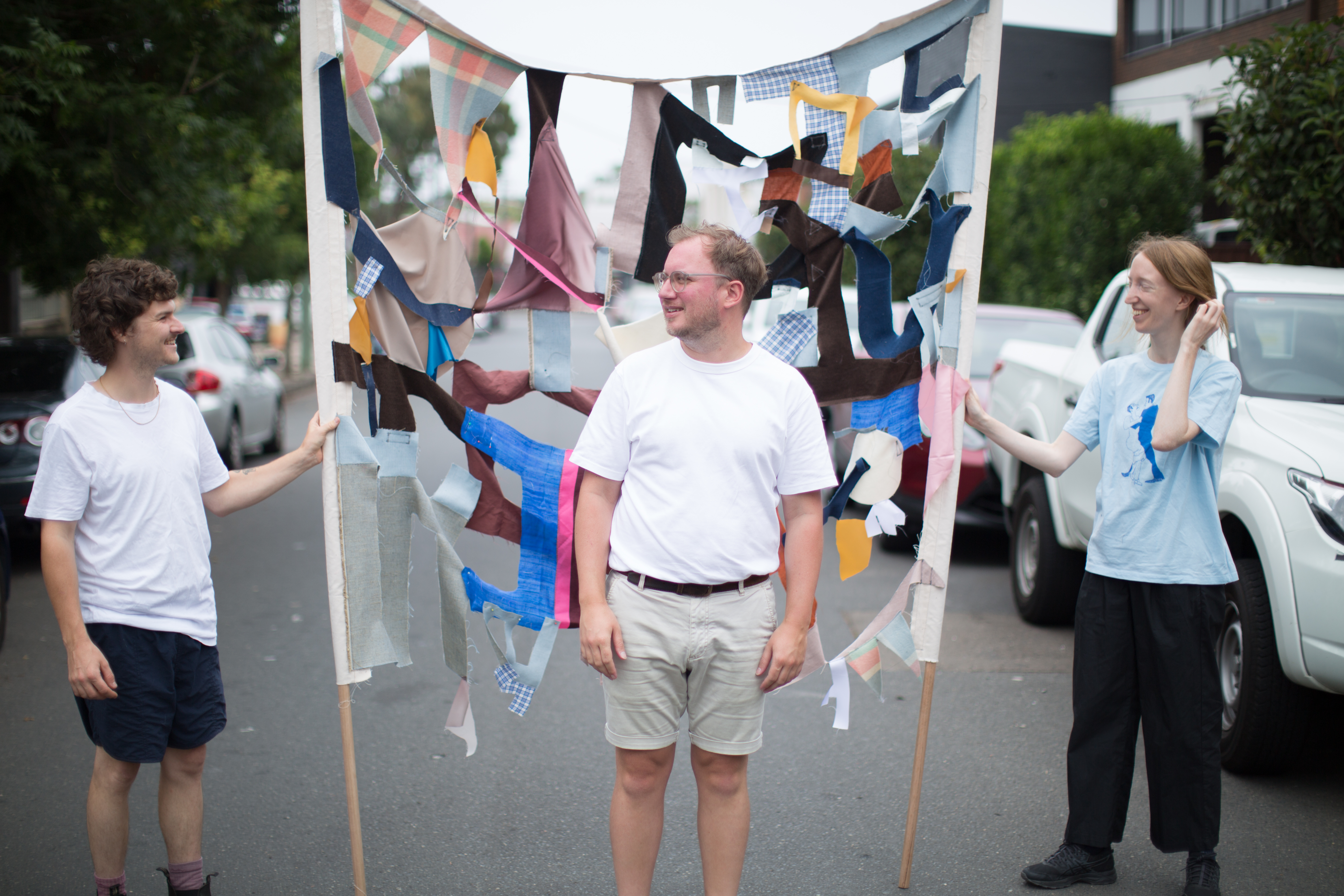
The Kookaburra Self-Relocation Project (WHOSLAUGHINGJACKASS) by Fernando do Campo took to the Launceston streets, interrogating colonialism and anthropocentrism.
The irreverent sound of laughter disrupted morning commuters in Launceston’s mall during early January as a flock of faux-protesters descended on the city as part of the MONA FOMA festival.
Armed with “beaks” and textile banners modelled in size on traditional union picket signs, the marchers and musicians played out an experiment in communication using the idiosyncratic birdcall of the kookaburra.
“It [was] like a kind of protest or an announcement,” says creator Fernando do Campo. “But when [bystanders] stop and listen, it will be nonsensical. The performers will egg each other on, and heckle each other, interrupting the landscape.”
The roving guerilla artwork, The Kookaburra Self-Relocation Project (WHOSLAUGHINGJACKASS), was the Argentinian Australian artist’s first foray into group performance as his medium – a risk he welcomed as both “exciting and threatening”. It takes its inspiration from the curious history of the kookaburra.
Known as the laughing jackass in 19th century Australia, the laughing kookaburra is synonymous with the Australian landscape. However, its presence in Tasmania (and Western Australia) was the result of human introduction from 1881-1906, according to archival records Mr do Campo discovered while researching the project.
With limited means to expand its collection, the City Park Zoo in Launceston traded thylacine (Tasmanian tiger) pups for kookaburras, the UNSW Art & Design Lecturer says. These kinds of species swaps were quite common at the time, even occurring across international waters.
Introduced initially in cages, kookaburras were subsequently released into the wild in Tasmania, he says, amounting to a kind of forced migration.
His artwork asks “what would happen if the kookaburra decided it wanted to relocate to the mainland, if it had some agency in its history”, Mr do Campo says. Significantly he counts the kookaburra itself as a contributor to the work, an animal collaborator in his research.
As a practice-led researcher, Mr do Campo explores socio-political questions through aesthetic abstractions. This project explores the nexus of colonialism and nationalism, human and non-human relationships, and the interplay of meaning and nonsense.

The kookaburra as emblem of nationalistic fervour around Federation
The introduction of kookaburras around the turn of the century marked a shift away from an earlier colonial distaste for the “uncanny” nature of Australian birdcalls (kookaburras and cockatoos come to mind), Mr do Campo says.
Rather than temper the nation’s unruly natural soundscape through the introduction of English species like the house sparrow, conservation societies began to embrace a new vision of Australia that celebrated its unique flora and fauna.
“Releasing the kookaburra’s laughter” into Tasmania and Western Australia exemplified the contemporary desire to present a “unified nationalistic version of the landscape” in the run up to independence, he says.
At the same time, the green and gold of wattle (another domestically mobilised species) and the red and blue of the Union Jack were adopted as the colours of Federation.
In this project, Mr do Campo challenges the validity of this palette, offering up instead the colours of the kookaburra – its dusky pink, baby blue and muted brown tones – as the colours of Federation. The textile banners and costumes of his “flock” are created in this scheme.
“Argentina and Australia – my two homes – are both colonial inventions,” he says. “Through the history of kookaburras in Tasmania, we can argue that ‘landscape’ was and always will be a construct.”
Challenging the Anthropocene and failing to communicate
Birdwatching is both a passion and a means of mediating his place in the world, Mr do Campo says. Locating and connecting with the bird species in the different cities he has lived has given him a greater sense of belonging in each new place.
The act of finding the familiar – a rock dove, a starling, a house sparrow – amongst the foreign is settling, he says. It mediates “the moments of confusion, nostalgia, double-vision, that occur when you attempt to locate yourself in a new place”.
As an immigrant himself with a somewhat nomadic upbringing – “we came to Australia for six months to learn English and see a kangaroo” and stayed – he is drawn to the migrating patterns of birds, and how humans have meddled with that.
The project aims to interrupt the way we think about human/non-human encounters and the way we process material, he says. It challenges anthropocentrism through “its commitment to listening to the non-human other”.
By using non-lexical sound (the kookaburra’s birdcall or laughter), it “embraces failure – the failure of humans to communicate with each other and with non-human species”, he says.
Communication is called into question, as both the audience and performers are drawn into the performative struggle to create meaning.

The 'luxury of leftovers'
The phrase ‘Who’s laughing jackass?’ has featured in Mr do Campo’s previous painting and typographic work. The phrase plays on the ambiguity of who is laughing and who is the jackass, he says.
For the most recent project, Mr do Campo abstracted the shapes of the letters to create the textile banners and the performers’ costumes. Removed from their original context, the shapes simultaneously take on new meaning and resonate with their original intent.
This is “the luxury of leftovers”, he says, where the vestiges of one work contribute to the next, endowing it with history and deeper meaning. This “speculative abstraction”, as he calls it, defines his practice through a commitment to “iterating constantly on an idea, and dwelling on it for as far as it can go”.
In the fray of MONA FOMA
MONA FOMA, which stands for the Museum of Old and New Art: Festival Of Music and Art, is an annual music and arts festival held in Launceston in January.
Once again curated by Violent Femmes’ Brian Ritchie, this year promised its usual fusion of low and high art with: outlandish installations, including a giant, breathing inflatable rabbit warren; absurd performances (a King Ubu puppet show); and a host of party shamen, punk cabaret divas and political pop provocateurs including Amanda Palmer, Paul Kelly and Slovenia’s Laibach set to grace Launceston.
The Kookaburra Self-Relocation Project (WHOSLAUGHINGJACKASS), with its deliciously unnerving, aesthetically alluring and potentially contagious queering of the everyday, fit right in.
The Kookaburra Self-Relocation Project (WHOSLAUGHINGJACKASS) was commissioned by Contemporary Arts Tasmania in collaboration with MONA FOMA and supported by grants from the Australian Council for the Arts, Create NSW and the UNSW Faculty of Research.
The performance was created in collaboration with IO Performance, Tasmania.
